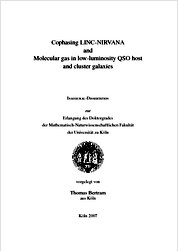Cophasing LINC-NIRVANA and molecular gas in low-luminosity QSO host and cluster galaxies
Bertram, Thomas
Univ. Köln
Monografie
Verlagsversion
Englisch
Bertram, Thomas, 2007: Cophasing LINC-NIRVANA and molecular gas in low-luminosity QSO host and cluster galaxies. Univ. Köln, 186 S., DOI: 10.23689/fidgeo-82.
 |
Dokument öffnen: |
This thesis consists of two parts. The first part reports on the development of a fringe tracking system for LINC-NIRVANA, the near-infrared homothetic imaging camera for the Large Binocular Telescope (LBT). LINC-NIRVANA allows for a coherent combination of the light entering the two primary mirrors. The fringe pattern in the focal plane is required to be stable in time to preserve the high spatial frequency information in long exposure images. Atmospheric differential piston causes the position of the fringes to change with time. A fringe tracker is a servo system that measures and corrects for atmospheric differential piston in real-time. In the first part, numerical simulations of atmospheric turbulence are used to investigate the problem of angular anisoplanatism of differential piston. The fringe tracking concept and the top-level requirements are introduced, followed by a presentation of the mechanical design of the system. This design includes a solution for a device that is capable of positioning a detector with high precision within a cryogenic environment. A fitting algorithm determines the amount of differential piston in the point-spread function of a reference target. The performance of this algorithm under different signal-to-noise conditions is investigated. First polychromatic fringes obtained with a testbed interferometer conclude the first part ...

